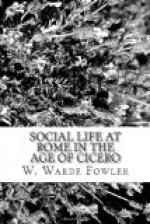There is no doubt then as to the fact of the presence of capital on a large scale in the Rome of the last century B.C., or of the business talents of many of its holders, or again of the many profitable ways in which it might be invested. But in order to learn a little more of the history of capital at Rome, which is of the utmost importance for a proper understanding not only of the economic, but of the social and ethical characteristics of the age, it is necessary to go as far back as the war with Hannibal at least.
That there had been surplus capital in the hands of individuals long before the war with Hannibal is a well known fact, proved by the old Roman law of debt, and by the traditions of the unhappy relations of debtor and creditor. But in order not to go back too far, we may notice a striking fact which meets us at the very outset of that momentous war. In 215 B.C., and again the next year, the treasury was almost empty; then for the first time, so far as we know, private individuals came to the rescue, and lent large sums to the State;[103] these were partners in certain associations to be described later on in this chapter, which had made money by undertaking State contracts in the previous wars. The presence of Hannibal in Italy strained the resources of the State to the utmost in every way; it cut the Romans off from their supply of the precious metals, forced them to reduce the weight of the as to one ounce, and, curiously enough, also to issue gold coins for the first time,—a measure probably taken on account of the dearth of silver,—and to make use of the uncoined gold in the treasury or in private hands. At the end of the war the supply of silver was recovered; henceforward all reckonings were made in silver, and the gold coinage was not long continued.
At this happy time, when Rome felt that she could breathe again after the final defeat of her deadly enemy, began the great inpouring of wealth of which the capitalism of Cicero’s time is the direct result. The chief sources of this wealth, so far as the State was concerned, were the indemnities paid by conquered peoples, especially Carthage and Antiochus of Syria, and the booty brought home by victorious




